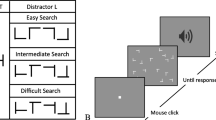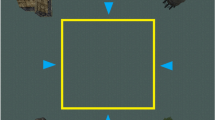Abstract
Recent evidence suggests humans optimally weight visual and haptic information (i.e., in inverse proportion to their variances). A more recent proposal is that spatial information (i.e., distance and direction) may also adhere to Bayesian principles and be weighted in an optimal fashion. A fundamental assumption of this proposal is that participants encode the variability of spatial information. In a three-dimensional virtual-environment open-field search task, we provide evidence that participants encoded the variability of landmark-based spatial information. Specifically, participants searched for a hidden goal location in a 5 × 5 matrix of raised bins. Participants experienced five training phases in which they searched for a hidden goal that maintained a unique spatial relationship to each of four distinct landmarks. Each landmark was assigned an a priori value of locational uncertainty such that each varied in its ability to predict a goal (i.e., varied in number of potential goal locations). Following training, participants experienced conflict trials in which two distinct landmarks were presented simultaneously. Participants preferentially responded to the landmark with the lower uncertainty value (i.e., smaller number of potential goal locations). Results provide empirical evidence for the encoding of variability of landmark-based spatial information and have implications for theoretical accounts of spatial learning.


Similar content being viewed by others
References
Arthur, E. J., Hancock, P. A., & Chrylser, S. T. (1997). The perception of spatial layout in real and virtual worlds. Ergonomics, 40, 69–77.
Bayes, T. (1763). Essays towards solving a problem in the doctrine of chances. Philosophical Transactions of the Royal Society, 53, 370–418.
Burgess, N. (2006). Spatial memory: How egocentric and allocentric combine. Trends in Cognitive Sciences, 10, 551–557.
Chamizo, V. D. (2003). Acquisition of knowledge about spatial location: Assessing the generality of the mechanism of learning. The Quarterly Journal of Experimental Psychology, 56B, 102–113.
Chamizo, V. D., Aznar-Casanova, J. A., & Artigas, A. A. (2003). Human overshadowing in a virtual pool: Simple guidance is a good competitor against local learning. Learning and Motivation, 34, 262–281.
Cheng, K. (1986). A purely geometric module in the rat’s spatial representation. Cognition, 23, 149–178.
Cheng, K. (2008). Whither geometry? Troubles of the geometric module. Trends in Cognitive Sciences, 12, 355–361.
Cheng, K., & Newcombe, N. S. (2005). Is there a geometric module for spatial orientation? Squaring theory and evidence. Psychonomic Bulletin & Review, 12, 1–23.
Cheng, K., & Newcombe, N. S. (2006). Geometry, features, and orientation in vertebrate animals: A pictorial review. In M. F. Brown & R. G. Cook (Eds.), Animal spatial cognition: Comparative, neural, and computational approaches. Available at http://www.pigeon.psy.tufts.edu/asc/cheng/.
Cheng, K., Shettleworth, S. J., Huttenlocher, J., & Rieser, J. J. (2007). Bayesian integration of spatial information. Psychological Bulletin, 133, 625–637.
Cheng, K., & Spetch, M. L. (2001). Blocking in landmark-based search in honeybees. Animal Learning & Behavior, 29, 1–9.
Dawson, M. R. W., Kelly, D. M., Spetch, M. L., & Dupuis, B. (2010). Using perceptrons to explore the reorientation task. Cognition, 114, 207–226.
Deneve, S., & Pouget, A. (2004). Bayesian multisensory integration and cross-modal spatial links. Journal of Physiology Paris, 98, 249–258.
Doeller, C. F., & Burgess, N. (2008). Distinct error-correcting and incidental learning location relative to landmarks and boundaries. In Proceedings of the National Academy of Sciences. (Vol.105, 5909–5914).
Doeller, C. F., King, J. A., & Burgess, N. (2008). Parallel striatal and hippocampal systems for landmarks and boundaries in spatial memory. In Proceedings of the National Academy of Sciences. (Vol. 105, 5915–5920).
Ernst, M. E., & Banks, M. S. (2002). Humans integrate visual and haptic information in a statistically optimal fashion. Nature, 415, 429–433.
Foo, P., Warren, W. H., Duchon, A., & Tarr, M. J. (2005). Do humans integrate routes into a cognitive map? Map- versus landmark-based navigation of novel shortcuts. Journal of Experimental Psychology: Learning, Memory, and Cognition, 31, 195–215.
Gallistel, C. R. (1990). The organization of learning. Cambridge, MA: MIT Press.
Gallistel, C. R. (2003). Conditioning from an information processing perspective. Behavioural Processes, 62, 89–101.
Gallistel, C. R., & Gibbon, J. (2001). Computational versus associative models of simple conditioning. Current Directions in Psychological Science, 10, 146–150.
Gillner, S., Weiß, A. M., & Mallot, H. A. (2008). Visual place recognition and homing in the absence of feature-based landmark information. Cognition, 109, 105–122.
Graham, M., Good, M. A., McGregor, A., & Pearce, J. M. (2006). Spatial learning based on the shape of the environment is influenced by properties of the objects forming the shape. Journal of Experimental Psychology: Animal Behavior Processes, 32, 44–59.
Gray, E. R., Bloomfield, L. L., Ferrey, A., Spetch, M. L., & Sturdy, C. B. (2005). Spatial encoding in mountain chickadees: Features overshadow geometry. Biology Letters, 1, 314–317.
Hartley, T., King, J. A., & Burgess, N. (2003). Studies of the neural basis of human navigation and memory. In K. Jeffery (Ed.), The neurobiology of spatial behavior (pp. 144–164). New York: Oxford University Press.
Healy, S. (1998). Spatial representation in animals. Oxford: Oxford University Press.
Jones, J. E., Antoniadis, E., Shettleworth, S. J., & Kamil, A. C. (2002). A comparative study of geometric rule learning by nutcrackers, pigeons, and jackdaws. Journal of Comparative Psychology, 116, 350–356.
Kamil, A. C., & Jones, J. E. (2000). Geometric rule learning by Clark’s nutcrackers. Journal of Experimental Psychology: Animal Behavior Processes, 26, 439–453.
Kelly, D. M., & Gibson, B. M. (2007). Spatial navigation: Spatial learning in real and virtual environments. Comparative Cognition & Behavior Reviews, 2, 111–124.
Klatzky, R. L., Loomis, J. M., Beall, A. C., Chance, S. S., & Golledge, R. G. (1998). Spatial updating of self-position and orientation during real, imagined, and virtual locomotion. Psychological Science, 9, 293–298.
Loomis, J. M., Blascovich, J. J., & Beall, A. C. (1999). Immersive virtual environment technology as a basic research tool in psychology. Behavior Research Methods, Instruments & Computers, 31, 557–564.
Miller, N. Y. (2009). Modeling the effects of enclosure size on geometry learning. Behavioural Processes, 80, 306–313.
Miller, N. Y., & Shettleworth, S. J. (2007). Learning about environmental geometry: An associative model. Journal of Experimental Psychology: Animal Behavior Processes, 33, 191–212.
Montello, D. R., Hegarty, M., Richardson, A. E., & Waller, D. (2004). Spatial memory of real environments, virtual environments, and maps. In G. L. Allen (Ed.), Human spatial memory (pp. 251–285). Mahwah, NJ: Lawrence Erlbaum Associates.
Mou, W., Biocca, F., Owen, C. B., Tang, A., Xiao, F., & Lim, L. (2004). Frames of reference in mobile augmented reality displays. Journal of Experimental Psychology: Applied, 10, 238–244.
Newcombe, N. S., & Ratliff, K. R. (2007). Explaining the development of spatial reorientation: Modularity-plus-language versus the emergence of adaptive combination. In J. Plumert & J. Spencer (Eds.), The emerging spatial mind (pp. 53–76). New York: Oxford.
Pearce, J. M., Graham, M., Good, M. A., Jones, P. M., & McGregor, A. (2006). Potentiation, overshadowing, and blocking of spatial learning based on the shape of the environment. Journal of Experimental Psychology: Animal Behavior Processes, 32, 201–214.
Péruch, P., & Gaunet, F. (1998). Virtual environments as a promising tool for investigating human spatial cognition. Current Psychology of Cognition, 17, 881–899.
Ponticorvo, M., & Miglino, O. (2010). Encoding geometric and non-geometric information: a study with evolved agents. Animal Cognition, 13, 157–174.
Ratliff, K. R., & Newcombe, N. S. (2008). Reorienting when cues conflict: Evidence for an adaptive combination view. Psychological Science, 19, 1301–1307.
Rescorla, R. A. (1988). Pavlovian conditioning: It’s not what you think it is. American Psychologist, 43, 151–160.
Rodrigo, T., Chamizo, V. D., McLaren, I. P., & Mackintosh, N. J. (1997). Blocking in the spatial domain. Journal of Experimental Psychology: Animal Behavior Processes, 23, 110–118.
Singer, R. A., Abroms, B. D., & Zentall, T. R. (2006). Formation of simple cognitive maps in rats. International Journal of Comparative Cognition, 19, 417–425.
Spetch, M. L., & Kelly, D. M. (2006). Comparative spatial cognition: Processes in landmark- and surface-based place finding. In E. A. Wasserman & T. R. Zentall (Eds.), Comparative cognition: Experimental explorations of animal intelligence (pp. 210–228). Oxford, England: Oxford University Press.
Steck, S. D., & Mallot, H. A. (2000). The role of global and local landmarks in virtual environment navigation. Presence: Teleoperators and Virtual Environments, 9, 69–83.
Sturz, B. R., Bodily, K. D., & Katz, J. S. (2006). Evidence against integration of spatial maps in humans. Animal Cognition, 9, 207–217.
Sturz, B. R., Bodily, K. D., Katz, J. S., & Kelly, D. M. (2009a). Evidence against integration of spatial maps in humans: Generality across real and virtual environments. Animal Cognition, 12, 237–247.
Sturz, B. R., Brown, M. F., & Kelly, D. M. (2009b). Facilitation of learning spatial relations among locations by visual cues: Implications for theoretical accounts of spatial learning. Psychonomic Bulletin & Review, 16, 306–312.
Sturz, B. R., & Diemer, S. M. (2010). Reorienting when cues conflict: A role for information content in spatial learning? Behavioural Processes, 83, 90–98.
Sturz, B. R., & Katz, J. S. (2009). Learning of absolute and relative distance and direction from discrete visual landmarks by pigeons (Columba livia). Journal of Comparative Psychology, 123, 90–113.
Sturz, B. R., & Kelly, D. M. (2009). Encoding of relative enclosure size in a dynamic three-dimensional virtual environment by humans. Behavioural Processes, 82, 223–227.
Sturz, B. R., Kelly, D. M., & Brown, M. F. (2009c). Facilitation of learning spatial relations among locations by visual cues: Generality across spatial configurations. Animal Cognition. doi:10.1007/s10071-009-0283-3.
Sutton, J. E. (2002). Multiple-landmark piloting in pigeons: Landmark configuration as a discriminative cue. Journal of Comparative Psychology, 116, 391–403.
Acknowledgments
This research was conducted following the relevant ethical guidelines for human research. We thank Paul Cooke, Stephanie Diemer, Sebastian Krzywanski, Martha Forloines, Shrinidhi Subramaniam, and especially Caroline Eastman and Rebecca Hattaway for their invaluable assistance with data collection and scoring. We are grateful for the comments by Fabio Ferlazzo, Kristin Ratliff, and an anonymous reviewer on an earlier version of this manuscript.
Author information
Authors and Affiliations
Corresponding authors
Rights and permissions
About this article
Cite this article
Sturz, B.R., Bodily, K.D. Encoding of variability of landmark-based spatial information. Psychological Research 74, 560–567 (2010). https://doi.org/10.1007/s00426-010-0277-4
Received:
Accepted:
Published:
Issue Date:
DOI: https://doi.org/10.1007/s00426-010-0277-4




